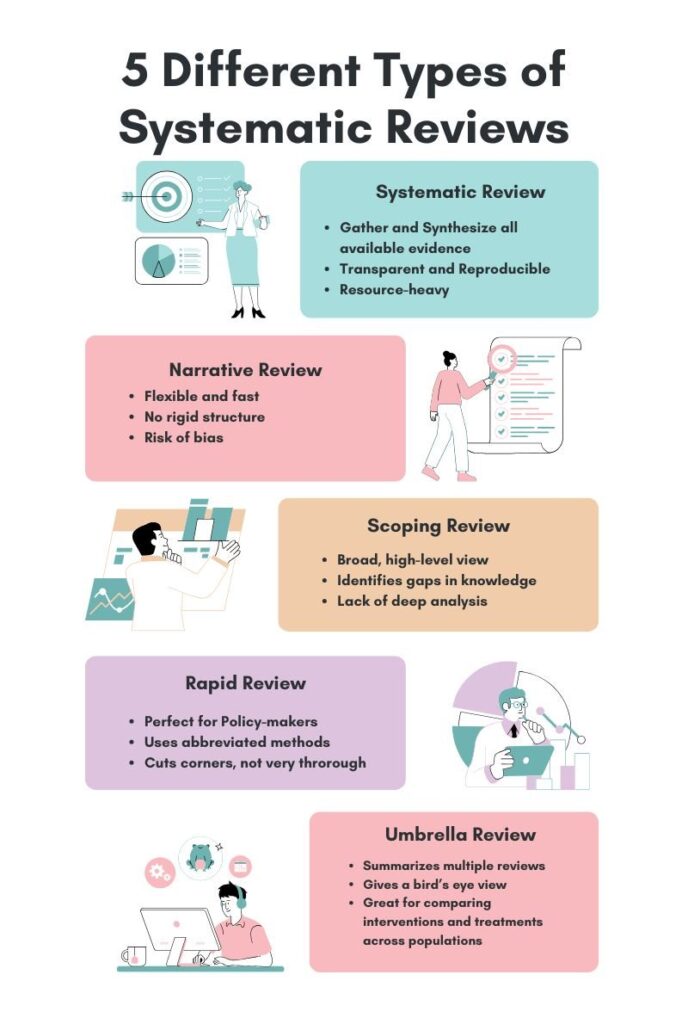

When you’re trying to navigate the ocean of literature, the types of scientific reviews you choose is like choosing your vessel.
Pick the wrong one, and you’ll drown in irrelevant information or surface with nothing valuable. Pick the right one, and you’ll come out armed with insights that push your research forward.
So, how do you decide which boat to board? In this guide, we’ll break down the different types of literature reviews, explaining the review types and how to match them with your research question. Let’s dive into the deep waters.
Before we get lost at sea, let’s first chart the map by defining the types of scientific reviews you’re likely to encounter in scientific research. Each has its purpose, pros, and cons. Here’s the rundown:
The systematic review is the king of the sea.
It follows a rigorous, structured approach to gather and synthesize all available evidence on a specific research question. By following predefined methods, it ensures the process is transparent and reproducible. These reviews leave no stone unturned, making them the go-to for clinical and healthcare fields. If you need bulletproof evidence, this is your vessel.
But here’s the kicker: systematic reviews are resource-heavy. They demand time, effort, and patience. If you don’t have those, you might want to look elsewhere.
A narrative review is more like a wide-net fishing expedition.
You’re skimming the surface, gathering broad information on a topic. There’s no rigid structure, so it’s flexible and fast—but that flexibility comes at a cost. Without strict methodologies, there’s a higher chance of bias creeping in. Still, it’s a great option for getting a general sense of a research area without diving deep.
Pros: Flexibility, speed.
Cons: Risk of bias, lacks rigor.
Sometimes, you’re not trying to find the answer to a single question. You’re trying to map out the terrain, seeing what’s out there.
That’s what a scoping review does. It identifies gaps in knowledge and pinpoints where further research is needed. If your research is still in the exploratory phase, and you’re figuring out what’s been done, a scoping review gives you a broad, high-level view.
Need answers fast?
The rapid review is the speedboat of the literature review world. It cuts corners—using abbreviated methods from systematic reviews to provide quick insights. It’s perfect for policymakers or time-sensitive research projects, but remember: what you gain in speed, you lose in thoroughness.
If you’re already standing on the shoulders of giants and want to summarize the results from multiple systematic reviews, the umbrella review is your best bet. This is the bird’s-eye view, compiling evidence from various reviews into one accessible document. Perfect for comparing interventions or treatments across different populations.

Now that we’ve charted the waters, let’s get into the nitty-gritty: how do you pick the right type of review for your research? Here’s how they stack up against each other.
If you need airtight results—no shortcuts—then a systematic review is your choice.
It’s designed to minimize bias and maximize the reliability of your conclusions. On the flip side, if your goal is simply to summarize the literature without digging too deep into methodology, a narrative review works just fine.
Key difference: Systematic reviews are structured, reproducible, and bias-resistant. Narrative reviews are flexible and faster, but more prone to bias.
These two often get mixed up, but here’s the deal: A systematised review adopts the same approach as a systematic review, but it doesn’t follow all the steps.
Think of it as a lighter, less intense version. Great if you want a structured approach but don’t have the resources for a full-blown systematic review.
Integrative reviews are the multitaskers.
They combine both qualitative and quantitative data to provide a more comprehensive view of a phenomenon. This is great for topics that span multiple disciplines or research methodologies. However, if you’re looking for the most rigorous evidence synthesis, systematic reviews still reign supreme.
Knowing the right review approach depends on your research goals. Here’s how to make sense of the typology of reviews:
If you’re trying to answer a specific, clinical research question, your go-to will be a systematic review. But if you’re mapping broad themes or areas where evidence is sparse, a scoping review or narrative review might be better suited. The trick is to align your review type with the scope of your research.
When you’re dealing with qualitative research, your review approach changes. Methods like meta-synthesis or thematic synthesis are essential to draw out deeper patterns and meanings across qualitative studies.
If you’re dealing with a mountain of data from other reviews, an umbrella review is your solution. You’re not hunting down individual studies; you’re looking at the big picture by synthesizing evidence from multiple systematic reviews.
Systemic refers to something affecting an entire system (not relevant here). A systematic review, however, is a specific methodology for synthesizing research evidence comprehensively and without bias.
A Cochrane review is a type of systematic review that adheres to strict guidelines set by the Cochrane Collaboration, a gold standard in healthcare research.
Every vessel has its strengths and weaknesses. Here’s how the different review types stack up:
Systematic, narrative, scoping, rapid, and umbrella reviews.
Depends on your goals. For specific, clinical questions, go with a systematic review. For broader topics, opt for a narrative or scoping review.
In the vast ocean of literature, knowing which ship to sail on is half the battle. Whether you need the rigorous depth of a systematic review, the speed of a rapid review, or the exploratory nature of a scoping review, the key is understanding the purpose of your journey.
If you’re still unsure, start by asking yourself: What’s my research question? How much time do I have? And how deep do I need to go? Pick the right review type, and you’ll be well on your way to conquering the ocean of literature with precision and confidence.